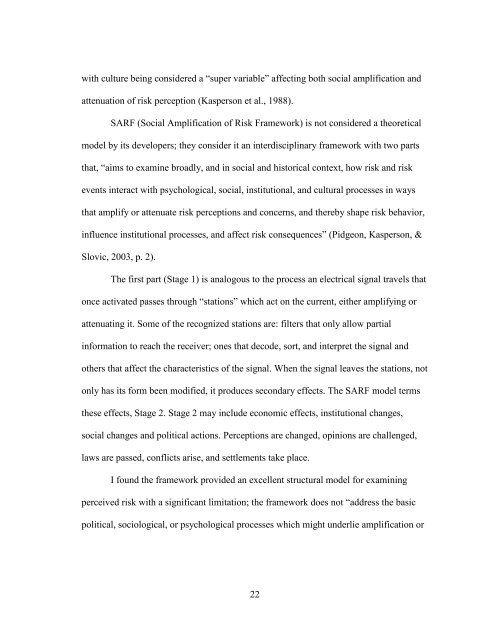PERCEIVED RISK AND THE SITING OF A CONTROVERSIAL ...
PERCEIVED RISK AND THE SITING OF A CONTROVERSIAL ...
PERCEIVED RISK AND THE SITING OF A CONTROVERSIAL ...
You also want an ePaper? Increase the reach of your titles
YUMPU automatically turns print PDFs into web optimized ePapers that Google loves.
with culture being considered a “super variable” affecting both social amplification and<br />
attenuation of risk perception (Kasperson et al., 1988).<br />
SARF (Social Amplification of Risk Framework) is not considered a theoretical<br />
model by its developers; they consider it an interdisciplinary framework with two parts<br />
that, “aims to examine broadly, and in social and historical context, how risk and risk<br />
events interact with psychological, social, institutional, and cultural processes in ways<br />
that amplify or attenuate risk perceptions and concerns, and thereby shape risk behavior,<br />
influence institutional processes, and affect risk consequences” (Pidgeon, Kasperson, &<br />
Slovic, 2003, p. 2).<br />
The first part (Stage 1) is analogous to the process an electrical signal travels that<br />
once activated passes through “stations” which act on the current, either amplifying or<br />
attenuating it. Some of the recognized stations are: filters that only allow partial<br />
information to reach the receiver; ones that decode, sort, and interpret the signal and<br />
others that affect the characteristics of the signal. When the signal leaves the stations, not<br />
only has its form been modified, it produces secondary effects. The SARF model terms<br />
these effects, Stage 2. Stage 2 may include economic effects, institutional changes,<br />
social changes and political actions. Perceptions are changed, opinions are challenged,<br />
laws are passed, conflicts arise, and settlements take place.<br />
I found the framework provided an excellent structural model for examining<br />
perceived risk with a significant limitation; the framework does not “address the basic<br />
political, sociological, or psychological processes which might underlie amplification or<br />
22
















